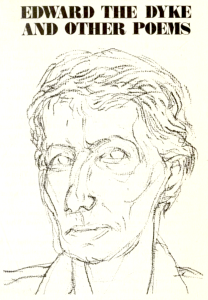The short poetic story, “Edward the Dyke” written by Judy Grahn in 1965 demonstrates society’s limited understanding of what women could be. This limited understanding is born from the erasure of lesbians and other radical women from history. Through this story Grahn is showing another way to be a woman and combating this erasure. The preservation of this story in archives also fights this erasure of women by remembering the way that lesbian women have been treated and viewed by society.
In this story, Edward is seeing a psychoanalyst who is trying to “cure” her. Edward starts the session off by saying “my problem this week chiefly concern[s] restrooms” and describes the physical assault she endured by the other women in the bathroom after they learned she was a lesbian (Grahn 26). The psychiatrist ignores what Edward says and instead writes down that Edward had an “apparent suicide attempt after accosting girls in restroom” (Grahn 26). The doctor’s dismissal of Edward’s concerns is repeated throughout the story. Edward describes a beautiful ten year relationship she had and the psychiatrist says “you see the folly of these brief physical embraces” (Grahn 28). Edward has a date with a man in which she dresses up, “does unspeakable things to [her] armpits with a razor” and “feels truly immobilized” by the clothes she wore (Grahn 29). The psychiatrist ignores her pain and says “good, good” and continues to force Edward into a box she will never fit in, in order to “cure” her (Grahn 29).

Illustration of Edward the Dyke from Judy Grahn’s collection of poetry, The Work of a Common Woman, published in 1978
However, this box is antithetical to her happiness. Edward only shows happiness when talking about her former lover or describing her identity as a lesbian. When the psychiatrist asks Edward to describe what homosexuality means to her, Edward uses beautiful imagery of “warm and water,” “cinnamon toast poetry” and “justice equality higher wages” (Grahn 27). Edward remembers her lover “laying in [Edward’s] arms harps played soft in dry firelight” (Grahn 28). It is clear through this powerful and beautiful language that Edward finds peace, beauty, and happiness in loving women.
This happiness is contrasted by the “treatment” the psychiatrist gives her. Firstly, Edward shouts “I am vile! I am vile!” after the psychiatrist has told her she “wants to kill her mother” and that she is narcissistic, masochistic, and sadistic (Grahn 30). Secondly, the shock therapy makes Edward scream in pain. The psychiatrist cares only about curing Edward’s homosexuality to fit her into heteronormative society. Edward, by the end of her session, has internalized this message and at the end of the shock therapy says, “I’m saved” (Grahn 30). Grahn warns about how easy it is for one to succumb to society’s view that lesbianism is wrong and unwomanly. Through satirizing the psychoanalytic process, this story proposes the idea that society’s view of womanhood is limited and incomplete. Grahn is attempting to validate and normalize the lesbian identity through satire. With the preservation of this story, future generations can turn to it to find comfort in knowing that their identity is valid, true and has been around for many years. By preserving this story in archives, this message will be available for future generations which allows for the lesbian liberation movement to grow and continue.
Works Cited:
Grahn, Judy. “Edward the Dyke.” The Work of a Common Woman, Diana Press, 1978.
